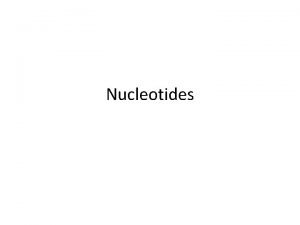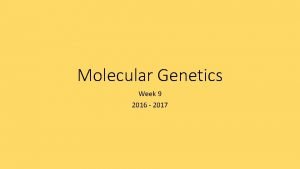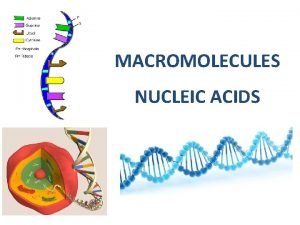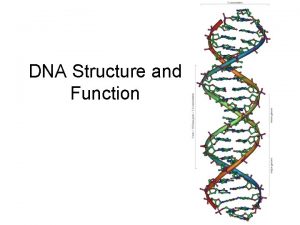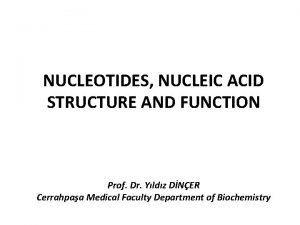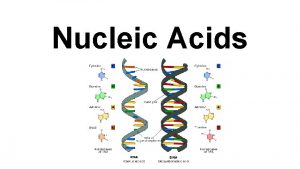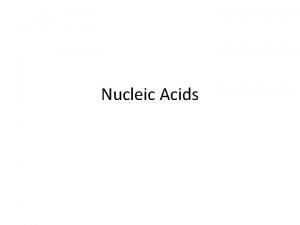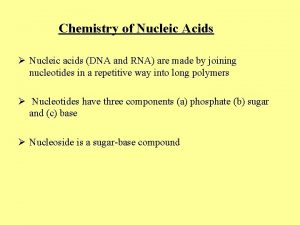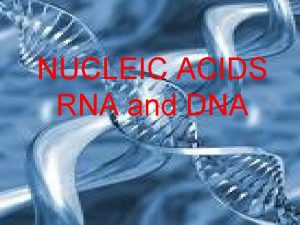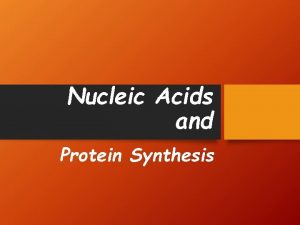DNA isolation DNA isolation Nucleic acids store and










- Slides: 10

DNA isolation

DNA isolation • Nucleic acids store and transmit hereditary information. • Deoxyribonucleic acid (DNA) is a molecule within the nucleus of a cell that contains genetic information. • Deoxyribonucleic acid (DNA) is wrapped around proteins called histones and arranged into chromosomes. Protein is not bound to prokaryotic DNA, but histone proteins are bound to the core DNA of eukaryotes. • DNA extraction is the first step for subsequent molecular or forensic analysis. DNA can be extracted from almost any intact cellular tissue such as skin, blood, saliva, mucus, muscle tissue, bone marrow, etc. • DNA extraction is the process by which DNA is separated from proteins, membranes and other cellular materials in the cell.

DNA isolation Many of the available DNA extraction methods have common procedures. The extraction of DNA generally follows three basic steps: 1. Lyse the cells. 2. Separate the DNA from the other cell components. Digest/denature the proteins and separate contaminants from DNA 3. Precipitate and isolate the DNA by centrifugation and chemicals (isopropanol) -The cell membrane is disrupted by any of the following methods: heat to increase fluidity, dithiothreitol (DTT) to break disulfide bonds, or using a detergent such as sodium dodecyl sulfate (SDS) to disrupt the membrane. -Heat denaturation or digestive enzymes such as proteinase K can be used to remove proteins from DNA.

DNA isolation • The structure of the DNA molecule is different from the protein and membrane in the cell, this situation gives us the chance to separate DNA from other molecules. • Detergent (sodium dodecyl sulfate, SDS) disrupts the cell structure and membrane. • Na. Cl binds DNA and selectively precipitates proteins. Na. Cl is also used to stabilize DNA after the removal of proteins.

DNA isolation • Denaturation of proteins is achieved by using sodium dodecyl sulfate (SDS), proteinase K, phenol and organic solvents. • SDS is a powerful detergent which separates proteins from DNA and denatures proteins. • Proteinase K is an enzyme that is active with SDS and breaks down proteins at 65 o. C.

DNA isolation • The precipitation of DNA is done chemically with some chemicals that increase precipitation, such as isopropanol. DNA is more soluble in the aqueous phase than in the organic phase. DNA is polar and therefore insoluble in organic solvents. • For example, the precipitation of DNA is easier with isopropanol.

The devices used in the DNA isolation • • Homogenizer It is a device that allows micro-spreading and dispersing of particles in the liquid. The material remains under the influence of high pressure and breaks down into micro-dimensions by homogenizer. With this method, the wall and membrane structures of the tissue or cells are destroyed. The mixture obtained is called "homogenate". In the homogenate, the cell structure is disappeared and the cell components (membrane pieces and some unbroken cells) are present as a dispersed suspension.

Solutions used in DNA isolation • Core dissolution buffer • -SDS (sodium dodecyl sulfate) solution • -Na. Cl solution • -Isopropanol

DNA isolation Material: Rat liver • The liver tissue is homogenized with the core dissolution buffer in the ice bath. • Add 0. 5 ml of sodium dodecyl sulfate (SDS) solution onto the homogenate. • It is kept on ice bath for 10 min and 2 ml of 6 M Na. Cl solution is added. • The solution is thoroughly mixed with vortex. • After mixing, centrifuge is performed. • After centrifugation, the upper liquid part (supernatant) is taken up in another tube. • An equal volume of isopropanol is added and the tube is turned upside down to make the DNA strands visible.

References • Ankara University Faculty of Pharmacy Biochemistry Practice Book-2004 • Practical Biochemistry (2015). Aljebory, A. , And Alsalman, A. • A Laboratory Text Book of Biochemistry, Molecular Biology and Microbiology (2014) • Lehninger Principles of Biochemistry- 5 th Edition (2008) • Elkins, K. M. (2013). DNA Extraction. Forensic DNA Biology, 39– 52.
